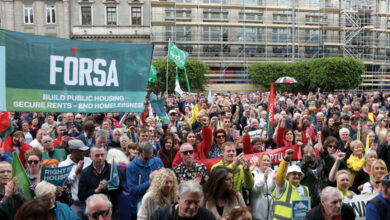Rebuilding Ireland


The head of the new Housing Market Policy and Land Management group within the Department of Housing, Barry Quinlan, has expressed a prevailing commitment across central government to ensure the full implementation of a strategy to facilitate adequate housing supply and tackle homelessness.
An architect of the Rebuilding Ireland – Action Plan for Housing and Homelessness strategy, Quinlan told the eolas Magazine Housing Conference that an active approach to State land management will be a key driver for the Government as it seeks to build the significant number of new dwellings required to meet the country’s housing needs. He added that the delivery of the action plan will require the active input and cooperation of all relevant government agencies.
“Housing is a basic social need. It is also crucially important for the effective running of the economy as a whole. After the economic collapse, the housing sector imploded. Naturally this had a major, knock-on effect, regarding the numbers of new houses coming on to the market. He added: “Housing has been one of the last sectors to recover in the wake of the recent economic upturn.”
Quinlan emphasised that the Irish economy has recovered quickly and increasing population and employment has meant that a significant increase in new homes is needed for a growing and working economy, and to address the significant level of social housing need. Under-provision of housing, whether by insufficient construction of new housing or existing housing not being used to its full potential, is one of the last significant legacies of the economic downturn to be tackled.
Quinlan confirmed a need for 25,000 new homes to be built annually in Ireland for the foreseeable future. “The current completion level is in the region of 14,000 units. So there is a significant gap to be bridged. And making our housing target a reality will require a significant investment on the part of the private and public sectors.”
Quinlan elaborated and noted that the new housing target will require an all embracing plan which will impact on the private, public, social and rental sectors. He also made it clear that land availability will not be a constraining issue in the context of implementing the Rebuilding Ireland strategy. “Enough new land has already been zoned in the greater Dublin area to get us started,” he said. “But we also need to see better utilisation of the housing stock that is already on the ground. There is also a requirement to provide affordable housing for first time buyers.”
As outlined by Quinlan, the Rebuilding Ireland plan comprises five pillars. These are:
- address homelessness;
- accelerate social housing;
- build more homes;
- improve the rental sector; and
- utilise existing housing.
He insisted that the right mix of resources must be mobilised in order to increase housing output, (particularly at more affordable prices), encourage the delivery of more and better rental options, keep people in their homes and bring vacant and under-utilised properties back into full use.
“We are now in the implementation phase of the project. Our aim is to do away with the need for emergency housing in 2017. This will reflect the needs of families with young children and homeless people, many of whom have chronic physical and mental problems to cope with.”
Quinlan acknowledged that the range of actions set out in the national rebuilding plan is ambitious. An investment of €5.5 billion in social housing and housing infrastructure will be delivered over the coming years. This will result in the development of 47,000 new housing units up to 2021.
“We know the scale of the problem: it’s now a case of getting on with the job in hand. There is a genuine commitment across all aspects of central government to ensure that the Rebuilding Ireland strategy is implanted in full.”





